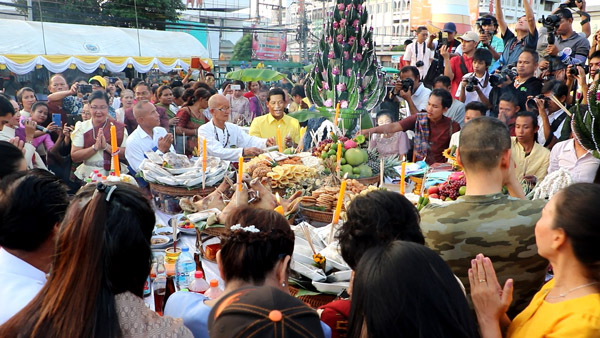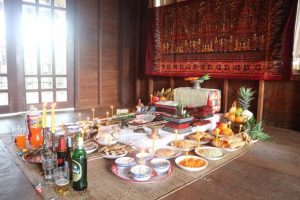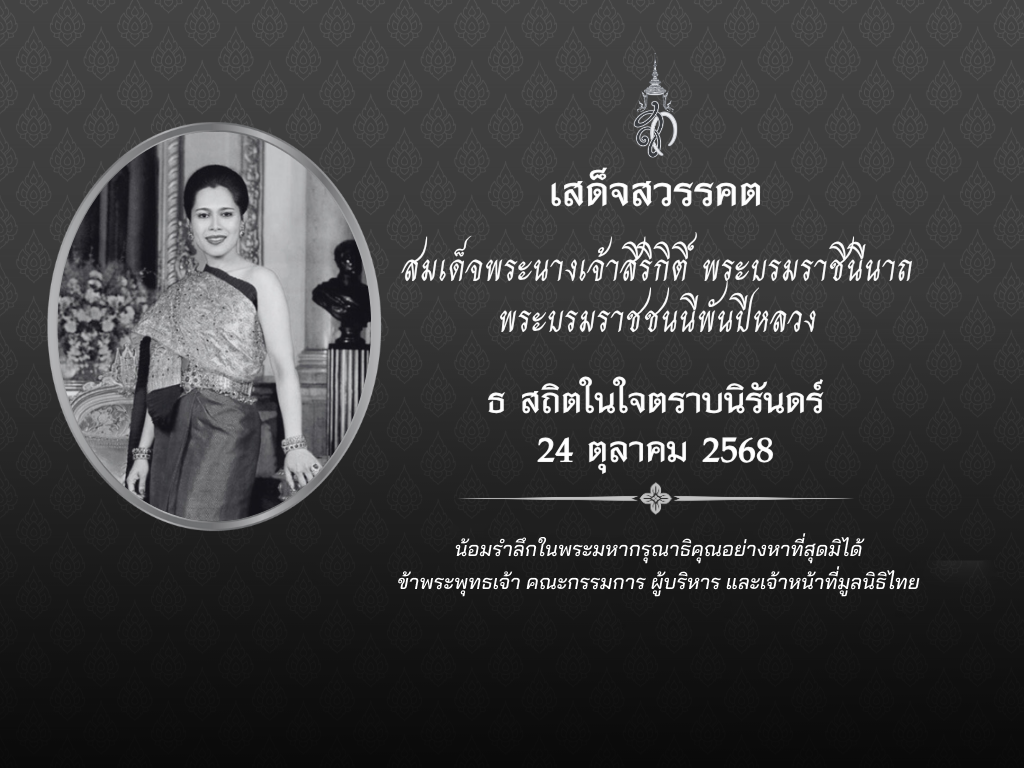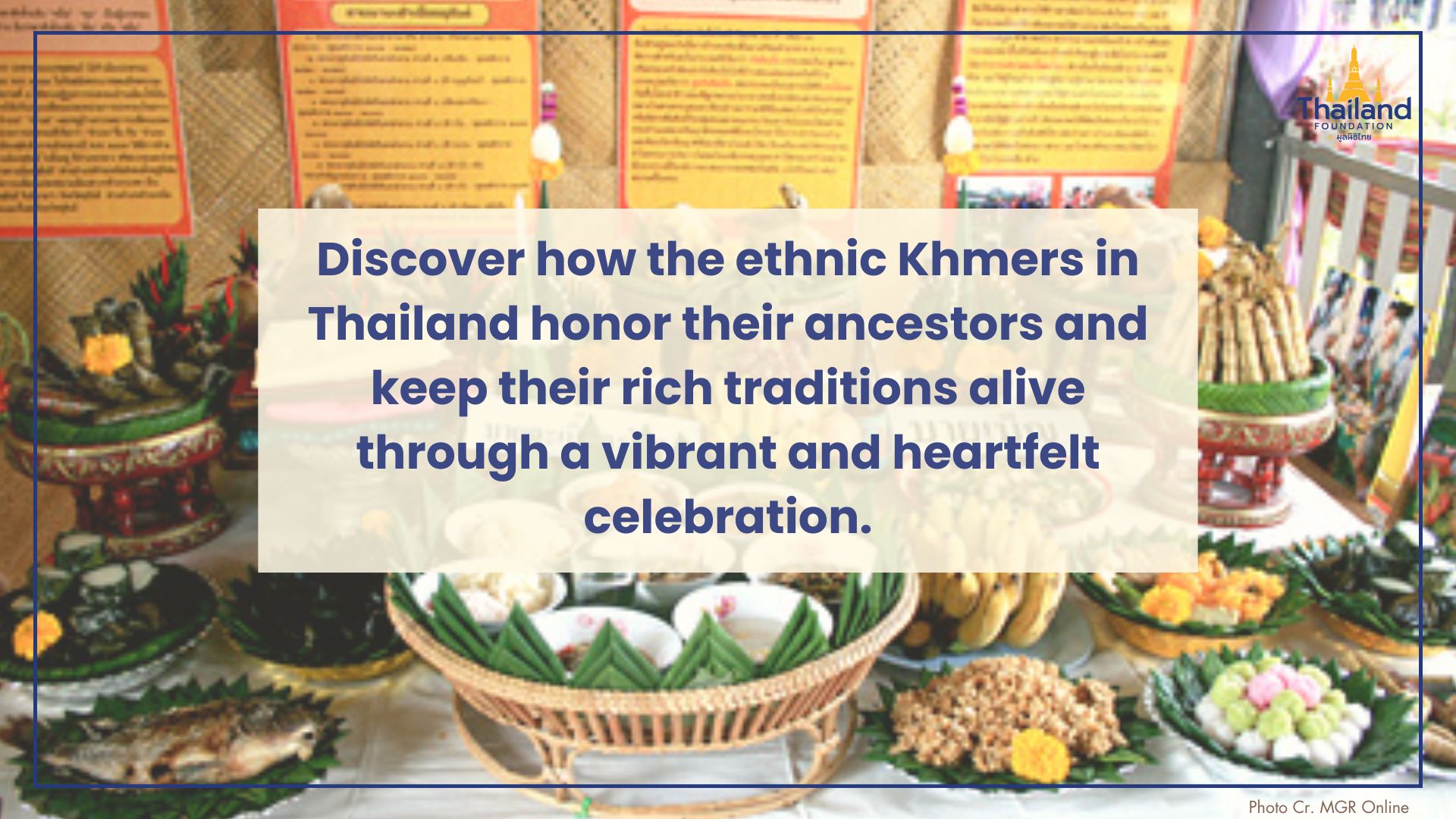
The past plays a vital role in shaping who we are today. For many people, maintaining a connection with the past, especially with family members and ancestors who have passed away, is an essential aspect of understanding their identity and roots. Across different cultures, people have come up with various ways to honor and remember those who came before them, keeping their memories and shared connections alive.
Thailand is home to a rich tapestry of diverse ethnic groups, each with unique traditions to celebrate and honor their deceased family members and ancestors. Today, we will explore how the ethnic Khmer communities in Thailand celebrate Saen Don Ta (แซนโฎนตา), a festival dedicated to paying respect and showing gratitude to their ancestors, ensuring their spirit remains a cherished part of the present.
What is Saen Don Ta?
Saen Don Ta (แซนโฎนตา) is a traditional festival observed by the ethnic Khmer community to honor and pay respect to their ancestors. It serves as a time to remember and express gratitude to those who have passed away. The festival is celebrated annually during the 10th lunar month, typically falling in September or October.
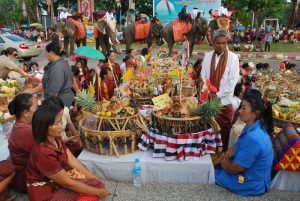
Saen Don Ta (แซนโฎนตา)
Photo Cr. matichon
While it is known as “Saen Don Ta” among ethnic Khmers in Thailand and Khmer Krom communities in Vietnam, the same festival is referred to as “Pchum Ben” in Cambodia. Despite the different names, the core purpose of the festival remains the same across these regions: to maintain a strong bond between the living and their ancestors.
Who are the Ethnic Khmers of Thailand?
The ethnic Khmers of Thailand, also known as Khmer Lue (ขแมร์ลือ) or Northern Khmers, are a community with deep historical and cultural roots in the country. They are descendants of the Khmer people, who have long inhabited the regions of Southeast Asia, even before the establishment of modern national borders. Over time, due to changes in political boundaries and migration, these communities became integrated into Thai society while still preserving their distinct ethnic identity.
The language spoken by the ethnic Khmers in Thailand is a distinct dialect of the Khmer language known as the Northern Khmer language. Despite living in a predominantly Thai-speaking environment, many ethnic Khmers continue to speak their native language. The use of Khmer is particularly strong among older generations, while younger generations are often bilingual, speaking both Khmer and Thai.
Today, the ethnic Khmer communities are predominantly found in the region known as “Lower Isan,” or the Lower Northeastern region, especially in Surin, Sisaket, and Buriram provinces. Although they are now part of the broader Thai society, the ethnic Khmers of Thailand have managed to retain many of their cultural practices, making them a vibrant and unique ethnic group within the country.
Beliefs and Spirituality
For the ethnic Khmers, beliefs about ghosts and spirits play a significant role in their daily lives and cultural practices. They believe that spirits, both benevolent and malevolent, inhabit the world around them. These spirits can belong to nature, such as those residing in trees, rivers, or mountains, and they can also be ancestral spirits who continue to maintain a presence among their living descendants. These beings can influence the fortunes and well-being of the living, requiring proper respect, offerings, and rituals to ensure harmony and protection.
An important part of these beliefs is the profound reverence for ancestors. The ethnic Khmers believe that their ancestors continue to watch over them, guiding and protecting them from harm. It is thus essential to maintain a respectful and nurturing relationship with these spirits, as they are thought to have the power to bless their descendants with good fortune, health, and prosperity. Conversely, if neglected or forgotten, the spirits may become displeased, resulting in misfortune or illness befalling the family.
The festival of Saen Don Ta (แซนโฎนตา) reflects these beliefs and serves as a way to honor and reconnect with ancestors. During this time, the ethnic Khmers believe that the gates of the afterlife open, allowing the spirits of the deceased to visit their living descendants. To ensure the spirits are welcomed and well-treated, families prepare offerings of food, drinks, and other items that the spirits enjoyed during their lifetime. There are also taboos and rules observed during the festival, such as avoiding arguments, refraining from speaking ill of others, and dressing respectfully. These actions show reverence and help prevent offending the spirits, ensuring the family’s continued blessings and protection.
Photo Cr. MGR Online
Saen Don Ta Celebration in Thailand
Saen Don Ta (แซนโฎนตา) is a multi-day celebration that involves careful preparation, ritual activities, and offerings to honor the ancestors. The festival typically spans three days, each with its unique significance and customs.
Preparation
Before the festival begins, ethnic Khmer families start preparing by gathering all the necessary items for the ceremonies. These include food offerings such as sticky rice, bananas, fruits, meat, and various traditional sweets, such as khao tom mat (ข้าวต้มมัด), which are sticky rice wrapped in banana leaves with a banana filling. Other items include incense sticks, candles, flowers, and new clothing. The preparation period is essential, as it symbolizes the family’s respect and readiness to welcome their ancestors back into their lives. The household must be cleaned, and the offerings are arranged neatly, reflecting the belief that everything should be in order to honor the spirits.
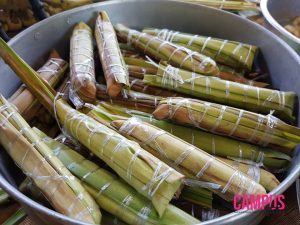
Khao tom mat (ข้าวต้มมัด)
Photo Cr. lifestyle.campus
Day 1: The Day of Small Offerings (วันเบ็ณฑ์ตู๊จ)
The first day of the festival is known as Wan Bent Tooj (วันเบ็ณฑ์ตู๊จ) or “Day of Small Offerings,” which falls on the 14th day of the waxing moon of the 10th lunar month. On this day, families prepare small offerings at home and bring them to the temple. Khao tom mat is considered an exceptionally important offering for this occasion. These offerings are meant to inform the ancestors and the spirits that the festival is about to begin. It is believed that this day serves as an invitation for the spirits to return to the world of the living, and it also lets Yama, the Lord of Death, know that the living are ready to welcome their ancestors. Monks are invited to chant prayers, and food offerings are made to them to gain merit, which is then transferred to the deceased.
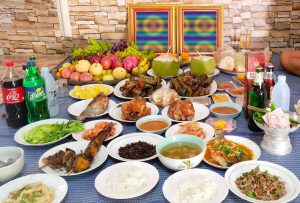
Photo Cr. lifestyle.campus
Day 2: The Day of Gathering (วันกันซ็อง)
The second day is known as Wan Kan Song (วันกันซ็อง) or “Day of Gathering.” It coincides with the full moon, the 15th day of the waxing moon of the 10th lunar month. It is a day when families gather at the temple to make more significant offerings and participate in communal activities. Each family brings food, flowers, candles, incense, and special dishes, to the temple, where they are offered to the monks. This day is marked by chanting, prayers, and merit-making, with the belief that the merit generated will be transferred to the ancestors, ensuring their happiness and well-being. This collective ritual not only strengthens the bond with the ancestors but also fosters unity among the community members.
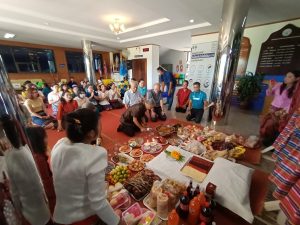
Wan Kan Song (Day of Gathering)
Photo Cr. Facebook: เทศบาลตำบลกระสัง
Day 3: The Grand Offering Day (วันแซนโฎนตา / วันเบ็ณฑ์ธม)
The third and final day is known as Wan Saen Don Ta (วันแซนโฎนตา) or Wan Bent Thom (วันเบ็ณฑ์ธม), or the “Grand Offering Day,” which occurs on the 14th day of the waning moon. It is the most significant day of the festival and is believed to be the time when all ancestors are released from the spirit world to receive the offerings. On this day, families perform the grand offering ritual at home, where a large meal is prepared featuring various dishes, fruits, sweets, and drinks that the ancestors enjoyed. The eldest member of the family leads the ceremony, lighting candles and incense, and inviting the spirits to partake in the feast. Family members gather around, and prayers are recited, expressing gratitude and seeking blessings from the ancestors. In addition to honoring their own ancestors, people may also visit other households to pay respect to the deceased individuals they are not related to but regard with deep respect, as though they were family members.
Afterward
Once the grand ceremony concludes, the remaining food is shared among family members, symbolizing the blessings received from the ancestors. In some communities, families will take the offerings to a nearby river, pond, or forest to release them, symbolizing the return of the spirits to their world. The offerings may also be spread in agricultural fields, ensuring a successful harvest. It is believed that this ritual ensures the spirits find their way back to the afterlife, where they will rest until the next Saen Don Ta celebration.
The Saen Don Ta festival is more than just a ritual; it serves as a time for family reunions, where relatives from different places come together, reinforcing bonds and strengthening their shared heritage. This celebration of gratitude and remembrance allows the ethnic Khmers to maintain a deep connection with their ancestors and cultural traditions, passing them down from generation to generation.
Photo Cr. MGR Online
Offerings to the Ancestors
An undeniably crucial component of the Saen Don Ta is the wide array of. Each item presented holds deep meaning and symbolism, representing respect, gratitude, and the connection between the living and the departed.
Khao Tom Mat (ข้าวต้มมัด) : Sticky rice wrapped in banana leaves is one of the most important offerings. The stickiness of the rice symbolizes unity, family bonds, and the desire for all members of the family to remain close to one another, just as the rice sticks together.
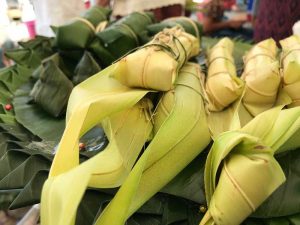
Khao Tom Mat (ข้าวต้มมัด)
Photo Cr. แนวหน้า
Meat Dishes: Commonly, boiled chicken, duck, or pork are offered. These meat dishes are believed to provide nourishment and energy for the spirits, ensuring they have the strength to continue their journey. The type of meat used can vary depending on what the deceased family members enjoyed during their lifetime.
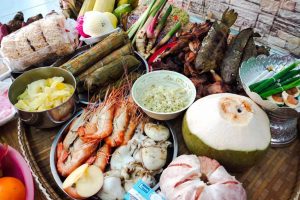
Photo Cr. culturio.sac.or.th
Fruits: Various fruits, especially bananas and coconuts, are presented during the ceremony. Bananas represent fertility, abundance, and prosperity, while coconuts symbolize purity and the cycle of life, as every part of the coconut tree can be used for different purposes.
Traditional Sweets: Several types of traditional sweets, such as khanom thian (ขนมเทียน), khanom nang let (ขนมนางเล็ด), and khanom khai hong (ขนมไข่หงส์), are included in the offerings. These sweets, made from sticky rice, coconut milk, and sugar, represent the sweetness of life and the hope that the ancestors will experience happiness in the afterlife.
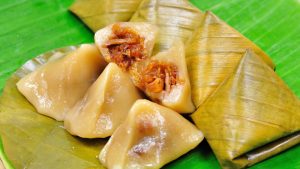
Khanom thian (ขนมเทียน)
Photo Cr. dessertsmat
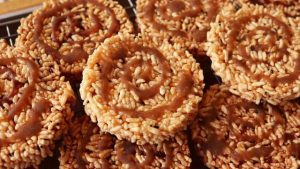
Khanom nang let (ขนมนางเล็ด)
Photo Cr. arit.kpru
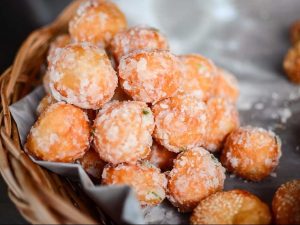
Khanom khai hong (ขนมไข่หงส์)
Photo Cr. patternpack
Flowers and Incense: Flowers, particularly fragrant ones, are used to honor the ancestors and symbolize purity, beauty, and respect. Incense sticks are lit as a way to communicate with the spirits, and their smoke represents prayers rising to the heavens, connecting the living with the spiritual world.
Clothing and Household Items: New, unused clothing, as well as small household items like combs, mirrors, or blankets, are often included in the offerings. These items symbolize care and comfort, ensuring that the ancestors are well taken care of in the afterlife, just as they were during their time on Earth.
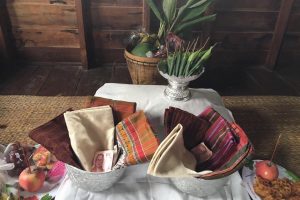
Photo Cr. Community Archive
Candles and Oil Lamps: Candles and oil lamps are lit as part of the offerings to guide the spirits to the family’s home. The light represents the hope that the ancestors will find their way to receive the offerings and the warmth of the family’s love and respect for them.
Photo Cr. Community Archive
Values Behind the Festival
The Saen Don Ta festival embodies several core values that are deeply ingrained in the ethnic Khmer community. Some of the most important are respect and gratitude, demonstrated through the act of remembering and honoring ancestors and deceased family members, ensuring they are never forgotten and remain an integral part of the family’s legacy. The festival also emphasizes connection, as it serves to maintain a strong familial bond, not only with the departed but also among the living, reinforcing ties within the family and the wider community.
Another significant value is compassion. During the festival, families express their concern for the well-being of their ancestors, offering food and prayers to send them merits, ensuring they are cared for even in the afterlife. This act of compassion extends beyond the immediate family, fostering empathy within the community.
Finally, the festival demonstrates a sense of openness, as it seamlessly blends animistic ancestral worship with Buddhist concepts of karma and merit-making. This openness reflects the community’s ability to adapt and integrate diverse spiritual beliefs, creating a rich and harmonious tradition that honors both their cultural heritage and spiritual values.
Conclusion
Thailand is a diverse and open country, where many ethnic groups maintain their unique customs and traditions while living harmoniously alongside one another. The Saen Don Ta celebration serves as a testament to the ethnic Khmer community’s deep commitment to preserving their cultural heritage and maintaining a strong connection with their ancestors. Through this festival, they not only honor their past but also keep their traditions alive, ensuring that future generations continue to cherish and respect the values that define their identity.
The story of “Saen Don Ta” is a small, but fascinating, facet that one may not immediately think of when discussing cultural heritages in Thailand. This festival is a way for the ethnic Khmer community to maintain their cultural identity and connection with their ancestors through reverence and spirituality. It is a testament to the cultural richness found within Thailand. Join us in exploring more stories of Thailand and its people, as we take you on a journey to discover the essence of Thainess.
◊◊◊
*This article is written with the help of AI.
Sources:
- Community Archive; Princess Maha Chakri Sirindhorn Anthropology Centre
https://communityarchive.sac.or.th/blog/218
- Intangible Cultural Heritage of Thailand; Department of Cultural Promotion
https://ich-thailand.org/article/detail/63217f19b4ed5aa030321aac
Written by: Tayud Mongkolrat



